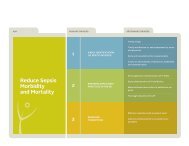The Nurse's Role in Medication Reconciliation - BC Patient Safety ...
The Nurse's Role in Medication Reconciliation - BC Patient Safety ...
The Nurse's Role in Medication Reconciliation - BC Patient Safety ...
You also want an ePaper? Increase the reach of your titles
YUMPU automatically turns print PDFs into web optimized ePapers that Google loves.
<strong>The</strong> Nurse’s <strong>Role</strong> <strong>in</strong> <strong>Medication</strong> <strong>Safety</strong><br />
• If and when the patient ever needs to be hospitalized, the updated medication<br />
list from the primary care chart can be used with ease as the medication reconciliation/physician<br />
<strong>in</strong>itial medication order form <strong>in</strong> the hospital chart. <strong>The</strong> only<br />
items required will be the physician signature, date, and time at the bottom of<br />
the list, and they can be <strong>in</strong>cluded <strong>in</strong> the admission paperwork as medications<br />
reconciled and medications ordered, thus sav<strong>in</strong>g time and steps and ensur<strong>in</strong>g<br />
each patient’s medication safety.<br />
Creat<strong>in</strong>g <strong>Medication</strong> Cards for <strong>Patient</strong>s<br />
While one task force of nurses was formatt<strong>in</strong>g the Master <strong>Medication</strong> List,<br />
another small task force of nurses from the primary care network was design<strong>in</strong>g a<br />
medication card for patients. <strong>The</strong> hospital system trialed several tests of change <strong>in</strong><br />
one outpatient sett<strong>in</strong>g. Once aga<strong>in</strong>, it was necessary to enlist the help of a multidiscipl<strong>in</strong>ary<br />
team composed of nurses, physicians, and patients (who were go<strong>in</strong>g to be<br />
us<strong>in</strong>g this medication card). Not only did the medication card list the patient’s<br />
demographics and the primary care physician’s name and telephone number, it conta<strong>in</strong>ed<br />
a section for the patient’s brief medical history, a place to denote<br />
allergies/<strong>in</strong>tolerances, and a grid <strong>in</strong> which to list current medications (<strong>in</strong>clud<strong>in</strong>g<br />
herbals and supplements and over-the-counter drugs) that the patient was currently<br />
tak<strong>in</strong>g. <strong>The</strong> grid also <strong>in</strong>cluded a place to list the dose (by simply ask<strong>in</strong>g, “How<br />
much?”), the route, the frequency (by ask<strong>in</strong>g, “How often?”), and the reason why.<br />
(<strong>The</strong> language used was basic to facilitate teach<strong>in</strong>g and learn<strong>in</strong>g.) This grid on the<br />
patient’s medication card was designed exactly like the columns on the <strong>in</strong>patient<br />
medication reconciliation form. Soon, all patients who entered the outpatient arena<br />
would be given <strong>in</strong>structions on how to fill out their medication cards. <strong>The</strong>y were<br />
also <strong>in</strong>structed to br<strong>in</strong>g these cards with them each time they had an office visit so<br />
that their medication lists could and would be updated, ensur<strong>in</strong>g their safety. (See<br />
the medication card for patients <strong>in</strong> Figure 1-3 on pages 21–22.)<br />
For those patients who have not received a medication card from the outpatient<br />
sett<strong>in</strong>g, a blank card is <strong>in</strong>cluded <strong>in</strong> the paperwork for all patients who are<br />
admitted and discharged from the hospital. Often nurses on these units assist<br />
patients or their families with fill<strong>in</strong>g out the medication cards. Nurses encourage<br />
patients to update their medication cards at discharge. <strong>The</strong> Lourdes system has<br />
found that it only takes a few moments for a nurse to teach a patient about the<br />
importance of the right drug, dose, route, and the reason for their medications. At<br />
the same time, nurses can give medication-<strong>in</strong>formation teach<strong>in</strong>g sheets to patients<br />
and their family members. <strong>The</strong>se sheets describe any new medication <strong>in</strong>itiated as<br />
well as dosage, adm<strong>in</strong>istration, side effects, and contra<strong>in</strong>dications. This is not a new<br />
20



